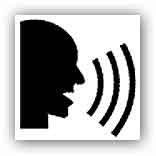|
A new study revealed the patterns of brain activity
that produce human speech. The findings may one day
lead to new approaches for treating speech disorders.

Most of us barely give a conscious thought to the
process of speaking, but it’s one of the most
complex actions we perform. In order to speak, your
brain needs to quickly and precisely coordinate your
lips, jaw, tongue and larynx (voice box). Speech
disorders, such as stuttering, affect roughly 5% of
children by the first grade. The underlying causes
of most speech disorders, however, aren’t well
understood.
Past studies have found that a part of the human
brain called the ventral sensorimotor cortex, or
vSMC, controls speech. Using electrical stimulation,
researchers were able to discover which general
areas of the vSMC controlled which parts of the face
and mouth. However, this kind of stimulation couldn’t
evoke meaningful utterances. The finding implies
that rather than being stored in discrete brain
areas, speech sounds might arise from coordinated
motor patterns involving multiple areas.
A team led by Dr. Edward Chang of the University of
California, San Francisco, set out to better
understand speech processing in the brain. To do
this, they recorded neural activity from the brain
surfaces of 3 people who were implanted with
electrode arrays as part of their preparation for
brain surgery. The electrical recordings were
matched with microphone recordings as the subjects
read syllables aloud.
The researchers identified about 30 active electrode
sites per subject. Analysis of the recordings
revealed that different sounds were coordinated in
dynamic, complex patterns of activity involving
different brain regions. Electrical patterns in the
brain transitioned within tens of milliseconds
between distinct representations for different
consonants and vowels.
Regions of brain activity during speech have a
hierarchical, overlapping structure organized by
phonetic features, the scientists found. For example,
consonants that require similar tongue locations
have overlapping areas of activity.
The patterns of brain activity differ most between
consonants and vowels. The researchers say that this
may explain why slips of the tongue usually involve
substituting consonants for consonants, or vowels
for vowels, but very rarely mixing them up with each
other.
“Even though we used English, we found the key
patterns observed were ones that linguists have
observed in languages around the world—perhaps
suggesting universal principles for speaking across
all cultures,” Chang says.
This work sheds light on a unique human ability: the
power of complex speech. The findings may help guide
potential treatments for speech disorders and the
development of brain-computer interfaces for
artificial speech.
The study was funded in part by NIH’s National
Institute of Neurological Disorders and Stroke (NINDS)
and National Institute on Deafness and Other
Communication Disorders (NIDCD). Results appeared
online on February 20, 2013, in Nature.
For more information
Nature. 2013 Feb 20. doi: 10.1038/nature11911. [Epub
ahead of print]. PMID: 23426266.
http://www.ncbi.nlm.nih.gov/pubmed/23426266
(MDN)
|
![]()